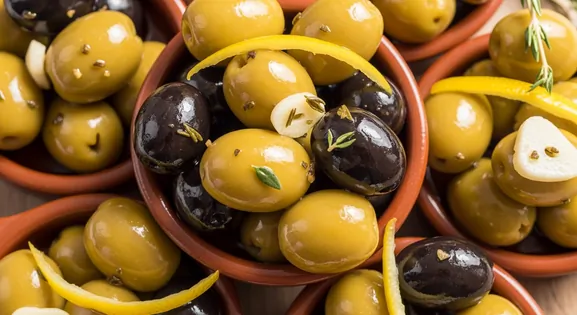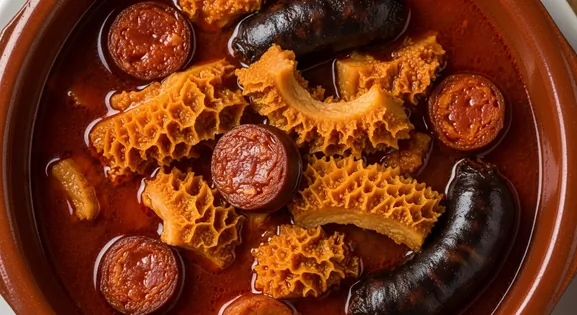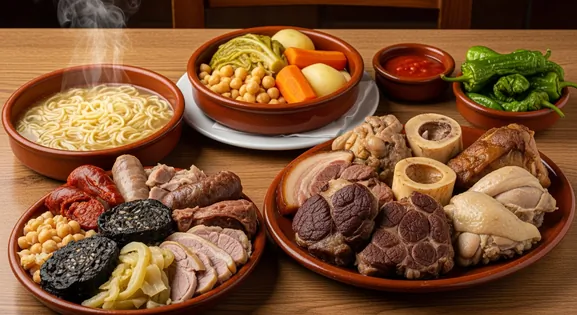Berenjenas con Miel in Spain: A Complete Food Lover's Guide
Berenjenas con Miel

What is Berenjenas con Miel (Eggplant with Honey)?
Berenjenas con Miel is a beloved Andalusian tapa featuring thin slices of eggplant, lightly battered and deep-fried until golden and crispy, then generously drizzled with honey or sugarcane molasses. This delightful contrast of savory, crispy eggplant with sweet honey creates a uniquely satisfying flavor profile that represents the Moorish influence on Southern Spanish cuisine.
Traditional Preparation Techniques
Fresh eggplants are thinly sliced (5-7mm), lightly salted to draw out moisture, then patted dry. The slices are dipped in seasoned wheat flour or a light batter (sometimes with sparkling water for extra crispness), then deep-fried in clean, hot olive oil until golden brown and crispy. The critical technique is maintaining the right oil temperature: too low and they absorb too much oil, too high and they burn before cooking through. Once drained, the hot eggplant is immediately drizzled with quality honey or sugarcane molasses just before serving.
Key Ingredients of Berenjenas con Miel (Eggplant with Honey)
Eggplant (Berenjena)
Thinly sliced, firm eggplants are essential. They should be fresh, with smooth, shiny skin and a vibrant purple color, ensuring a tender interior when cooked.
Quality indicator: Look for firm, unblemished eggplants that feel heavy for their size, indicating good moisture content.
Honey (Miel) or Sugarcane Molasses (Miel de Caña)
The sweet counterpoint to the savory eggplant. Honey provides a floral sweetness, while miel de caña offers a darker, more robust, and slightly bitter flavor.
Quality indicator: Choose high-quality, local honey or authentic miel de caña for the best flavor profile and traditional experience.
Wheat Flour Batter
A light, crispy batter made from wheat flour, sometimes mixed with sparkling water or beer for extra crispness. It should coat the eggplant thinly, allowing it to cook evenly.
Quality indicator: The batter should be golden-brown and airy, not thick, doughy, or overly greasy, indicating proper frying technique.
Classic Pairings for Berenjenas con Miel (Eggplant with Honey)
Dry Sherry (Fino or Manzanilla)
Wine
The crisp, dry, and slightly saline notes of a Fino or Manzanilla sherry cut through the richness of the fried eggplant and complement the sweetness of the honey, creating a balanced palate.
Light Lager or Pale Ale
Beer
A refreshing, crisp lager or a hoppy pale ale provides a clean contrast to the sweet and savory flavors, cleansing the palate and enhancing the overall enjoyment of the dish.
The Story Behind the Dish
This dish reflects the strong Moorish heritage in Andalusian cuisine, combining Arab techniques of frying with the use of honey as a sweetener, both introduced during the 8+ centuries of Islamic rule in the region. The contrast of sweet and savory flavors is characteristic of North African and Middle Eastern influences that remain embedded in Andalusian culinary traditions. Originally a humble homemade dish, it gained popularity as a tapa in the mid-20th century.
Local Berenjenas con Miel (Eggplant with Honey) Variations in Spain
Berenjenas con Miel de Caña
Instead of bee honey, this version uses sugarcane molasses, which has a darker, slightly more bitter flavor profile. Very common in Andalusia and preferred by many locals for its robust flavor.
Berenjenas Crujientes
Extra-crispy version with a lighter batter, sometimes using carbonated water to increase crispiness. Often served with the honey/molasses on the side for dipping.
Berenjenas con Queso y Miel
A modern twist where goat cheese or blue cheese is sprinkled over the hot berenjenas before the honey, creating a melted cheese layer between the eggplant and sweetener.
Berenjenas a la Cordobesa
A variation often prepared with a more substantial batter and typically served with miel de caña rather than honey, known for its hearty style.
Universal Quality Indicators
What to Look For
-
Freshly fried to order
Quality establishments fry berenjenas just before serving, ensuring optimal taste and peak freshness. Listen for the sound of active frying and watch for freshly prepared batches.
-
Clean, clear oil
The frying oil should be clean and not overly dark or smoky, indicating it's been changed regularly. Old oil affects taste and can indicate poor quality.
-
Crispy exterior, tender interior
Properly cooked berenjenas have a golden-brown crispy coating with completely cooked eggplant inside. Undercooking risks raw flour consumption while overcooking creates bitter, acrid flavors.
-
Honey/molasses applied after frying
The honey should be drizzled just before serving, not mixed in during cooking. This preserves the crispy texture and ensures the freshness of both components.
What to avoid
-
Pre-fried, reheated berenjenas
Avoid places serving pre-fried batches that are reheated to order. These will be soggy, greasy, and may indicate suboptimal handling.
-
Overly thick batter
Authentic berenjenas have a light, crisp coating. An excessively thick, doughy batter often indicates poor preparation and may mask lower quality eggplant.
-
Dark, smoking oil
Oil that's very dark or smoking indicates it's overused and contains byproducts from repeated frying at high temperatures, affecting flavor.
-
Soggy, oil-saturated eggplant
The berenjenas should not leave a pool of oil on the plate. Excessive oiliness indicates improper frying temperature or inadequate draining.
Explore Berenjenas con Miel (Eggplant with Honey) in Detail: City Guides
Discover where to find the best Berenjenas con Miel (Eggplant with Honey) and learn local tips in these cities:
Dietary Information
Dietary Information
Important Note for Travelers: Your safety is our priority. Below are the common allergens associated with the traditional preparation of this dish. However, recipes and ingredients can vary significantly between establishments. Always confirm all ingredients directly with the food vendor before ordering, especially if you have a severe allergy.
Potential Allergens
Dietary Suitability
How to Order Berenjenas con Miel (Eggplant with Honey)
Frequently Asked Questions about Berenjenas con Miel (Eggplant with Honey)
What are Berenjenas con Miel?
Berenjenas con Miel is a traditional Andalusian tapa consisting of thinly sliced eggplant, lightly salted, then coated in a wheat flour batter and deep-fried until crispy. The hot, crispy eggplant slices are then drizzled with honey (miel) or sometimes sugarcane molasses (miel de caña), creating a delicious sweet-savory contrast. It's a staple dish throughout southern Spain.
Is Berenjenas con Miel vegetarian or vegan?
Berenjenas con Miel is typically vegetarian as it consists of eggplant, flour batter, and honey. However, it's not naturally vegan because of the honey. Some establishments may use egg in the batter, making it non-vegan. For a vegan version, ask if they can serve it with sugarcane molasses (miel de caña) instead of honey and confirm their batter doesn't contain egg (sin huevo).
How can I tell if Berenjenas con Miel will be good quality?
Look for places that fry the eggplant to order rather than reheating pre-fried batches. The eggplant should have a golden-brown, crispy coating, not dark or soggy. Quality establishments use thin slices of fresh eggplant, clean frying oil, and real honey or quality molasses. The dish should be served immediately after frying, with the honey drizzled just before serving so the eggplant maintains its crispness.
What's the difference between miel (honey) and miel de caña (sugarcane molasses)?
Traditional Berenjenas con Miel often uses bee honey (miel de abeja). However, many Andalusian establishments serve it with miel de caña (sugarcane molasses), which has a darker color and more robust, slightly bitter flavor. Miel de caña is plant-based, making it suitable for vegans. Some restaurants offer both options, so you can specify your preference.
How can travelers confidently enjoy Berenjenas con Miel?
Berenjenas con Miel is generally a good choice for travelers when prepared properly. Deep-frying at high temperatures ensures thorough cooking. Choose established venues with good hygiene practices and high turnover. Look for places where the dish is freshly prepared to order and the oil appears clean. The dish is best enjoyed hot and fresh.
Can people with gluten intolerance eat Berenjenas con Miel?
Traditional Berenjenas con Miel is not gluten-free due to the wheat flour batter. Those with celiac disease or gluten intolerance should avoid it unless the restaurant specifically offers a gluten-free version made with alternative flours like chickpea flour (harina de garbanzo). Always explicitly ask if they can prepare a gluten-free version (sin gluten) and inquire about preparation methods.
Expert How-To Guides about Berenjenas con Miel (Eggplant with Honey)
How to Spot Authentic Berenjenas con Miel
This guide helps you distinguish authentic Berenjenas con Miel from lesser quality versions often found in tourist-heavy areas, ensuring a truly delicious experience.
- Look for thinly sliced eggplant - authentic versions use slices about 5mm thick that cook quickly and evenly.
- Check the batter - it should be light and crispy, not thick and doughy.
- Observe the frying oil - it should be clean and hot, not dark or smoking.
- The honey or molasses should be drizzled just before serving, not pre-soaked.
- The eggplant inside should be tender but not mushy, maintaining some structural integrity.
- Authentic versions are usually served immediately after frying, still hot.
How to Choose the Best Tapas Bar for Berenjenas con Miel
Discover practical tips for selecting the best tapas bars and restaurants renowned for serving high-quality, freshly prepared Berenjenas con Miel.
- Look for busy places with a strong local presence – a good sign of authenticity.
- Check if they're frying food to order rather than reheating.
- Observe food preparation areas if visible – cleanliness is key.
- Ask if they use honey (miel de abeja) or sugarcane molasses (miel de caña).
- Look for places that specialize in fried tapas (frituras).
- Seek out bars known for traditional Andalusian cuisine.
How to Eat Berenjenas con Miel Like a Local
Master the local customs and etiquette to fully appreciate Berenjenas con Miel, ensuring an authentic and enjoyable dining experience.
- Use a toothpick or small fork provided to pick up the slices.
- Feel free to eat with your hands if toothpicks aren't available - it's casual food.
- Take a moment to appreciate the contrast of the crispy exterior and soft interior.
- Pair with a glass of dry sherry like Fino or Manzanilla for an authentic experience.
- Share the plate with friends - tapas are meant for sharing.
- Don't be shy about using bread to mop up extra honey at the end.
Our Commitment to Quality
At Tasteplorers, our mission is to provide the most accurate and useful travel information in the world. To achieve this, all content on this site is created through our unique editorial framework. We utilize leading AI research tools, guided by our proprietary prompts, and a multi-stage validation process. This entire system is overseen by our editorial team to ensure everything we publish meets our high standards for accuracy, cultural nuance, and practical value for travelers.
Learn more about our Editorial Process and our Mission.
Countries
Explore regions
Europe
Discover Europe's diverse culinary landscape, from Mediterranean flavors to hearty Alpine fare. Learn to navigate markets, decode menus, and eat like a local.
Latin America & Caribbean
Discover the vibrant cuisines of Latin America & the Caribbean. Our expert guide covers everything from Mexican street food to Peruvian ceviche and market tips.
Oceania
Explore Oceania's diverse food scene. Learn about Polynesian earth ovens, Fijian feasts, and the vibrant café culture of Australia and New Zealand.
Southeast Asia
Explore Southeast Asia's diverse food cultures from Thailand to Vietnam. Get expert tips on navigating spice levels, choosing quality vendors, and understanding the rich traditions of the region.









